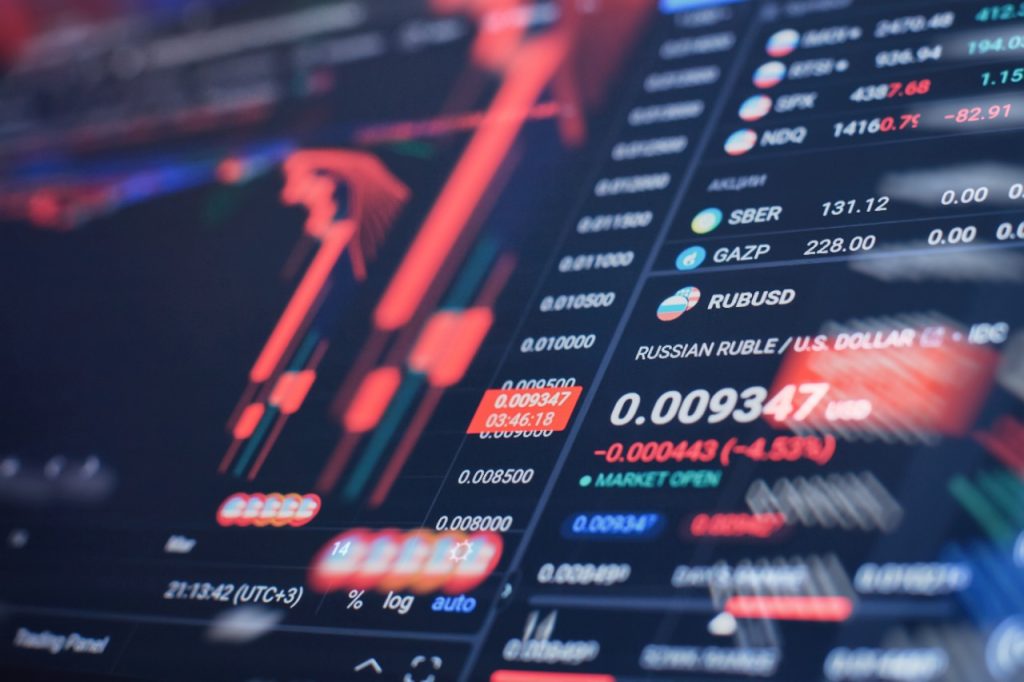Day trading is the act of buying and selling a financial instrument within the same day or even multiple times over the course of a day. Taking advantage of small price moves can be a lucrative game if it is played correctly.
What is day trading?
Day trading is an investment strategy in which a trader buys and sells financial instruments, such as stocks, currencies, commodities, or derivatives, within the same trading day. The goal of day trading is to make a profit by taking advantage of short-term price movements in the market. Day traders typically use technical analysis and charting tools to quickly identify profitable trades and make decisions. They also use stop-loss orders to limit potential losses. Day trading can be a high-risk, high-reward strategy that is not suitable for everyone. It requires discipline, patience, and a strong understanding of the market. It is also important to have good risk management practices in place to minimize potential losses
Day Trading Tips
Understand the market
- Before making any trades, it is essential to have a good understanding of the crypto market and the specific coins you plan to trade. This includes researching the coins, their technology, and their use cases.
Set clear goals
- Define your investment strategy and set clear goals for your trades. This will help you stay focused and avoid impulsive trades.
Use technical analysis
- Crypto markets are highly volatile, and technical analysis can help you identify patterns and trends that can indicate the best time to buy or sell
Use stop-loss orders
- Stop-loss orders are a way to limit your losses in case the market moves against you.
Diversify your portfolio
- Diversifying your portfolio can help reduce risk. Spread your investments across different coins and different sectors of the market.
Don’t FOMO
- Fear of missing out is a common pitfall in the crypto market. Don’t let it drive your trades. Instead, stick to your investment strategy and wait for the right opportunities.
Keep track of your trades
- Keeping a record of your trades will help you learn from your successes and failures and make more informed decisions in the future.
Stay updated
- The crypto market is a fast-moving one, so it’s important to stay informed about news and developments that could affect the value of the coins you hold.
All Eggs
- Don’t put all your eggs in one basket, be prepared to walk away with a profit or a loss.
Over Leverage
- Don’t over-leverage yourself. Only invest what you can afford to lose.

Why is day trading difficult?
Day trading can be difficult for a variety of reasons, such as:
High volatility
- Crypto markets are highly volatile, and prices can change rapidly, making it difficult to predict market movements and identify profitable trades.
Emotions
- Day trading can be emotionally challenging, as traders often face the pressure of making quick decisions and the fear of losing money.
Lack of discipline
- Day trading requires discipline, patience, and a strong market understanding. Without these, traders may make impulsive decisions and fail to stick to their investment strategy.
Risk Management
- Day trading requires a strong risk management strategy, but many traders are not prepared to handle the potential losses that come with this type of trading.
Knowing when to get out
- Day traders must have a clear plan for making a profit and cutting a loss. Many traders lack this plan and end up losing most of their gain.
Psychological factors
- Day trading can be very stressful and can take a toll on the trader’s mental and emotional well-being.
Lack of Knowledge
- Day trading requires a strong understanding of the market and the specific financial instruments being traded. Without this knowledge, traders may make poor decisions and suffer losses.
Constant monitoring
- Day trading requires constant monitoring of the market, which can be time-consuming and mentally taxing.
How to Figure Out What and When to Buy
Crypto-day traders aim to profit from small movements in the prices of various cryptocurrencies. They typically use a lot of borrowed money, also known as leverage, to increase their potential returns. Day traders typically consider liquidity, volatility, and market sentiment when deciding what to buy. They look for highly liquid cryptocurrencies that can be easily bought and sold in the market with minimal price impact. They also look for cryptocurrencies with high volatility, as this can offer more opportunities for profit. Day traders also pay close attention to market sentiment, as it can affect the price of the cryptocurrencies they are trading. By considering these factors, day traders aim to identify profitable trades and make quick decisions to capitalize on short-term price movements in the crypto market.
What to buy
Here are a few things to consider when deciding when to buy cryptocurrency:
- Liquidity: Day traders typically look for highly liquid financial instruments, meaning they can be easily bought and sold in the market with minimal price impact.
- Volatility: Day traders look for instruments with high volatility, as this can offer more opportunities for profit.
- Technical indicators: Day traders often use technical indicators such as moving averages, relative strength index (RSI), and Bollinger bands to identify patterns and trends in the market.
- News and events: Day traders pay close attention to news and events that could affect the price of the instruments they are trading. This includes earnings reports, economic data releases, and company announcements.
- Risk/reward ratio: Day traders typically look for trades with a favorable risk/reward ratio, meaning the potential profit outweighs the potential loss.
- Support and resistance levels: Day traders often pay close attention to support and resistance levels, which are price levels where the instrument has had difficulty breaking through in the past.
- Market sentiment: Day traders also consider the overall market sentiment, as it can affect the price of the instruments they are trading.
- Position size: Day traders also consider their position size, meaning the number of shares they buy or sell in a particular trade, in order to manage their risk.
- Volume: Day traders pay attention to trading volume, as it can indicate the strength of a trend and potential reversal points.
- Fundamentals: Day traders also look at the fundamentals of the underlying asset, such as financials, revenue, and management team
When to buy
Assuming you have already conducted research and analysis to decide what cryptocurrency to buy, the next step is identifying the most suitable entry points for the market. Some useful resources for finding these entry points include:
- ECN/ Level 2 quotes
- Real-time news services
- Intraday candlestick charts
How to Figure Out When to Sell
It is possible to exit a profitable trade using various strategies, such as trailing stops and predetermined profit targets. One of the most common exit strategies is to achieve a predetermined profit level. Common methods for maximizing profits include using a percentage of profits as a target, a multiple of your initial investment, or a combination of both. Additionally, traders may also use technical indicators such as moving averages, relative strength index (RSI), and Bollinger bands to identify potential exit points. It is also important to have a risk management plan in place to ensure that any potential losses are minimized. It is crucial to have an exit strategy in place before entering a trade and stick to it, in order to manage risk and maximize profits. Common methods for maximizing profits include:
- Scalping
- Momentum
- Fading
- Daily pivots
Day Trading Charts and Patterns
Day trading charts and patterns refer to the visualization of historical price and volume data of a financial instrument, such as a stock, currency, commodity, or cryptocurrency, over a specific period of time. Day traders use these charts to identify potential buying and selling opportunities in the market.
Charts are typically composed of a series of candlesticks, each representing the high, low, open, and close prices for a given period of time. Candlesticks in different colors, such as green and red, are used to indicate whether the closing price was higher or lower than the opening price.
Day traders use various chart patterns to identify potential buying and selling opportunities. Some common chart patterns include:
- Head and shoulders: A bearish pattern, indicating a potential reversal in the trend. It is characterized by a peak (the head) followed by a higher peak (the left shoulder) and a lower peak (the right shoulder).
- Double top and bottom: A reversal pattern that signals a potential trend change. It is characterized by two consecutive peaks or troughs of similar heights.
- Support and resistance: Prices bounce between support and resistance levels. Support is where the price tends to find buying pressure, and resistance is where the price tends to find selling pressure.
- Trend lines: are used to connect highs or lows and indicate the direction of the trend.
- Moving averages: are used to smooth out price data and indicate the direction of the trend
Actually, it is important to use them in conjunction with other analysis tools, such as fundamental analysis and market sentiment. And also, it’s important to remember that the crypto market is highly volatile, and prices can fluctuate rapidly. Day trading requires discipline, patience, and a strong market understanding.
How to Reduce Your Losses When Day Trading
- Risk management: Develop a plan to set stop-loss orders and take profits at pre-determined levels. This can help minimize potential losses and keep them under control.
- Position sizing: Be mindful of your position size and only trade with money you can afford to lose. Never risk more than a small percentage of your trading capital on any single trade.
- Diversification: Diversify your portfolio by investing in multiple coins. This can help reduce risk by spreading it out across different assets.
- Use stop-loss orders: A stop-loss order is an order to sell a security when it reaches a certain price, known as the stop price. This can help you limit your losses if the market moves against you.
- Cut your losses quickly: If a trade goes against you, don’t hold on to the hope that it will return in your favor. Cut your losses quickly and move on to the next trade.
- Don’t let emotions control your decisions: Fear and greed can cloud judgment and cause impulsive decision-making. Stay disciplined and stick to your trading plan.
- Keep learning: Keep learning about the market and new trading strategies. Stay informed about the current market conditions and new developments in the crypto industry.
What are Basic Day Trading Techniques?
Basic day trading techniques refer to traders’ strategies and methods to buy and sell financial instruments, such as stocks, currencies, commodities, or cryptocurrencies, within the same trading day. The goal is to profit from small price movements in the market. Here are a few basic day trading techniques:
- Scalping: This technique involves quickly taking advantage of small price movements by buying and selling a financial instrument. Scalpers aim to make a small profit on each trade, usually a few cents or dollars.
- Breakout trading: This technique involves buying or selling a financial instrument when it breaks through a key resistance or support level. The idea is to catch a trend early and ride it for a quick profit.
- Trend following: This technique involves identifying a trend in the market and buying or selling in the direction of the trend. Traders use technical indicators such as moving averages and trend lines to identify trends.
- Contrarian trading: This technique involves taking positions that are opposite of the current market trend. It’s based on the idea that markets tend to move in cycles and that the most profitable opportunities occur when the market is overbought or oversold.
- News trading: This technique involves buying or selling a financial instrument based on news and events that could affect the price of the instrument.
Which is Better for Day Trading; Technical or Fundamental Analysis?
- Both technical and fundamental analysis have their own advantages and disadvantages when it comes to day trading.
- Technical analysis studies past market data, primarily price, and volume, to identify patterns and make trading decisions. Technical traders use charts and technical indicators to identify patterns in the market and make predictions about future price movements. This approach is considered to be best suited for short-term trading and can be useful in identifying entry and exit points for trades.
- On the other hand, fundamental analysis is the study of the underlying economic, financial, and other qualitative and quantitative factors to determine the intrinsic value of an asset. This approach focuses on analyzing the financials of the company, including revenue, profit, and debt, and the overall market conditions and trends. This approach is considered to be best suited for long-term investments.






